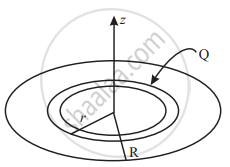Advertisements
Advertisements
Question
Calculate potential on the axis of a disc of radius R due to a charge Q uniformly distributed on its surface.
Solution

`σ = Q/(piR^2)`
`dU = 1/(4piε_0) (σ . 2pirdr)/sqrt(r^2 + z^2)`
∴ U = `(piσ)/(4piε_0) int_O^R (2rdr)/sqrt(r^2 + z^2)`
= `(2piσ)/(4piε_0) [sqrt(r^2 + z^2)]_O^R`
= `(2piσ)/(4piε_0) [sqrt(R^2 + z^2) - z]`
= `(2Q)/(4piε_0R^2) [sqrt(R^2 + z^2) - z]`
APPEARS IN
RELATED QUESTIONS
Draw a plot showing the variation of (i) electric field (E) and (ii) electric potential (V) with distance r due to a point charge Q.
Two charges −q and +q are located at points A (0, 0, −a) and B (0, 0, +a) respectively. How much work is done in moving a test charge from point P (7, 0, 0) to Q (−3, 0, 0)?
A hollow metal sphere and a solid metal sphere of equal radii are given equal charges. Which of the two will have higher potential?
Obtain an expression for electric potential ‘V’ at a point in an end-on position i.e. axial position of the electric dipole.
Electric Potential V at a point in an electrical field is ______.
Electric potential is potential energy ______.
Electric potential at a distance r from a point charges q is _________.
In a system of n point charges electric potential at a point P having a distance ri from the charge qi is ________.
Calculate potential on the axis of a ring due to charge Q uniformly distributed along the ring of radius R.
Calculate electric potential at a point P which is at a distance of 9 cm from a point charge of 50 μC.
